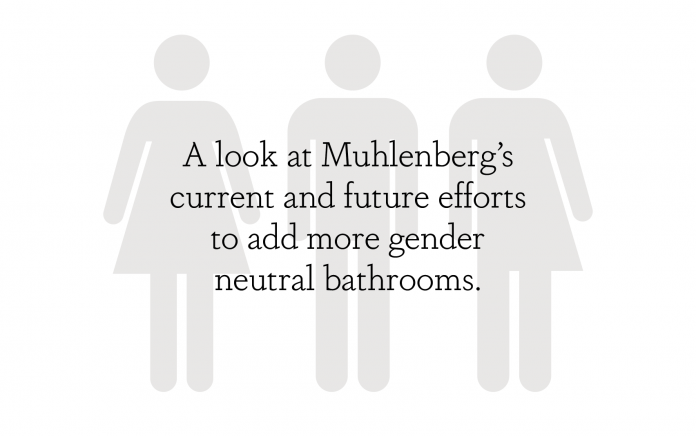Short and long-term plans for adding more gender-neutral bathrooms on campus are underway, including replacing select gendered bathrooms with gender neutral restrooms.
There are currently 17 bathrooms marked gender neutral on campus, and a committee chaired by Dean of Students Allison Gulati, which includes representatives of Students for Queer Advocacy (SQuAD), Muhlenberg Trans Advocacy Coalition (MTAC), Plant Operations, Student Government Association and Residential Services are looking to add more. The committee is currently drafting a statement of work, establishing a timeline and selecting which restrooms’ signage will be changed from men’s and women’s rooms to gender neutral. Much is still up for discussion and no dates have been set, but the overall goal of the project is to follow societal gender-inclusive and LGBTQ progress, affirm the college’s commitment to nonconforming and transgender community members and to make spaces more accessible to visitors and students of all gender identities.
“Part of the new strategic plan for the College and also specifically the plan for Student Affairs is to continue to make Muhlenberg as equitable and inclusive as possible.”
“Part of the new strategic plan for the College and also specifically the plan for Student Affairs is to continue to make Muhlenberg as equitable and inclusive as possible.” said Gulati. “I have experience leading projects related to the expansion of gender inclusive housing and restrooms and I am very excited to work with our students and faculty on this initiative. Our students in SGA, SQuAD and MTAC have already done significant ground work and will provide a strong foundation for us to build upon. I am very grateful for their commitment to this work.”
Alexa Urbach ‘18, one of the students on the committee and a member of SQuAd, has been pushing for gender neutral bathrooms her four years at ‘Berg.
“I believe that it’s essential to have these spaces for individuals whose gender identity doesn’t align with the binary of male and female,” said Urbach. “Gender inclusive bathrooms and/or housing is also important for students who are questioning their gender identity, unable to physically transition in the ways they’d like to or are in the process of transitioning and may not ‘pass’ as the gender they identify with.”
Posters appeared in the Seegers Union stairs, posted by SQuAd and MTAC, addressing Board of Trustee members and stating that “Moyer has more restrooms than required by building code — turning one restroom into a gender-neutral restroom would require no renovations and therefore no additional cost to the college.”
A large part of the project is simply getting proper signage, explained Dr. Mello, Associate Dean of Diversity and chairman of the President’s Diversity Advisory Council.
Part of Mello’s job as Associate Dean of Diversity is to oversee the implementation of the diversity strategic plan, introduced in 2013, part of which was creating gender-neutral bathroom signage. Gender neutral bathroom signs were introduced in 2015, and the campus map was updated in 2017 to include locations of all gender neutral restrooms on campus.
“So the plan was creating [gender neutral bathrooms] and clearly marking them so they could be easily identifiable on campus maps and also on signage in different buildings.” said Mello. “On a technical level, it was fulfilled. We did create some where there were none. We did post signage where there was none. I think for many students, and for those of us involved with President’s Diversity Advisory Council, just having one or two wasn’t enough. The idea was to look at ways we can expand gender neutral bathrooms, and the awareness of them is more accessible both on our webpage, on our campus maps.”
What’s up for discussion, said Mello, is how many bathrooms will be designated gender neutral, and how many will remain men and women’s restrooms. Some colleges, Mello noted, have only gender neutral bathrooms.
Additional initiatives in the strategic plan included online diversity training for faculty, making changing names on college records and IDs easier for trans students, better communicate gender-neutral housing policies to freshmen and add fostering inclusion, justice and social equity to job descriptions.
Chloe Gravereaux is the current Editor-in-Chief of the Muhlenberg Weekly, to which she has contributed since her freshman year. She dabbles in all forms of verbal and visual art, specializing in journalism and short fiction. Her unrivaled color coordination skills and investment in the dollar section of Target have earned her the nickname "Office Mom."






















